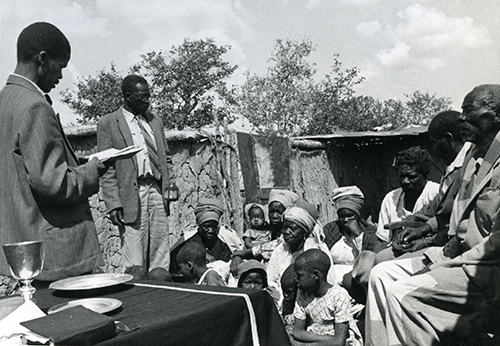Prof Paul John Isaak
Namibia’s rich history of the profound influences of African preachers has been finally researched and published.
Hans-Martin Milk´s ‘God’s feet or the mission’s pack donkey: Evangelists of Namibia’ interweaves the life stories of ELCRN evangelists with mission and church history from 1820 to 1990, based on interviews and archives.
Names and families
For the first time an author researched the full names – and if possible, also African names of all evangelists. This has to be highly appreciated since during the colonial era, these respected Africans were only referred to by their first names and often only were called “boys” by white people. In the attachment, the book impressively lists 700 evangelists for this period with their dates of birth and death, and congregations where they worked.
The title of the book is derived from how one of the former evangelists, pastor Joel Hanadaob (a former evangelist himself), described the general feeling of many evangelists, being often treated like “the running boy and pack donkey.”
Rectifications
Hans-Martin Milk, who grew up in Namibia in a Rhenish Mission Society (RMS) family, under apartheid, provides not only profiles of many evangelists, he also rectifies the view of mission and church history in Namibia being the history of only white European missionaries who were instrumental for cementing Christianity.
In this book, it is demonstrated that the Gospel was preached in many places on the soil of Namibia, first of all by these African evangelists, in what was formerly known as “Great Namaqualand” or in the first church building in Windhoek, built by Jonker Afrikaner. Among the first African missionaries was Jacob Links (1799-1825), who could read and write (unlike many European settlers around him) and could speak several languages.
The author also analyses the key roles of evangelists during the 1904 – 1908 genocide, by looking, for example, at the evangelist Samuel Kariko. Many Namibians were captured by the German army and sent to a concentration camp at Shark Island, where many died.
It was evangelists like Kariko (who survived the genocide), who made the atrocities known and brought it to the public attention. He described how some of the surviving people were starved and their bodies were merely skin and bone and looking like a broomstick; so thin that one could see through their bones. Kariko (who could communicate in five languages) wrote:
“There, on the island, were thousands of Herero and Nama prisoners. We had to live there. Men, women, and children were all huddled together. We had no proper clothing, no blankets, and the night air on the sea was bitterly cold. The wet sea fogs drenched us and made our teeth chatter. The people died there like flies that had been poisoned. The little children died first, and then women and the men. We begged and prayed and appealed for leave to go back to our [homes], which is warmer, but the Germans refused. They took our younger women to their camps as concubines.”
Breaking away
As the author makes clear, the establishment of the African Methodist Episcopal Church (AMEC) was a key moment in the history of the mission church, as it implied a breakaway from
the RMS. Pastor Petrus Jod, who wrote the first Namibian church history in 1908, described his experiences when he said that it did not matter that “myself, who received the best theological education during the period 1910–1939 within the RMS and who was regarded as the best-qualified and influential
Namibian theologian, but still my ordination was refused.” He commented upon such humiliating and degrading treatment by pointing out: “If you’re not white, it’s all futile.”
Even the few evangelists who remained in the RMS, like pastor Hendrik Samuel Isaak, criticised the personal and structural racism (which runs like a thread through the life stories of the evangelists) and the denial of the ordination of Africans. As he put it:
“Bright as in the daylight, I see the mistakes and injustices in important, old writings and reports of the missionaries, the abusive names and swear words they used and wrote against our forefathers, which today determine the attitude of some missionaries and Europeans.
Promises have not been kept. Some missionaries have treated us with contempt. But it is probably not right in divine matters to go one’s separate ways in strife and general unkindness and mutual
bitterness.
I and my wife have come to the conclusion that despite all the above facts, as the Lord wants and He gives us the necessary strength, we will remain with the RMS.”
He concluded that he would remain with the RMS until the leadership would be given over to Africans as a Lutheran Church – as happened at Okahandja in 1957.
The open letter and today’s challenges
One of the key voices among the churches that confronted apartheid was that of Pastor Paulus //Gowaseb.
In 1972, the Open Letter was published.
Consequently, there was a meeting between the Namibian Lutheran Church leadership and the South African apartheid regime’s powerful man, prime minister Vorster. Pastor //Gowaseb had this to say:
“It was impossible for us to remain silent for even longer when we see that our people are constantly treated as being
inferior and separated from one another by the laws of apartheid
and homeland policy. And now, because of your policies, we are being made strangers in our country of birth, because we have no
right.”
The work done by Hans-Martin Milk on the Evangelists needs to be continued by also studying the history of the first ELCRN pastors. I am, therefore, inviting a group of four/five members of the ELCRN to come together with me so that we do research and publish such a book before the end of 2025, which is also the end year of our current church leadership.
*Professor Paul John Isaak is Emeritus Professor in Church History at UNAM and Paulinium.


